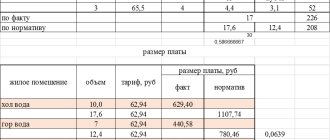Tariffs and standards
HomeQuestion-answer Tariffs and standards
Standards:
1. Order No. 162-RV dated December 9, 2014 “On approval of standards for the consumption of utility services”
2. Order dated May 22, 2017 No. 63-RV “On approval of standards for the consumption of utility resources for the purpose of maintaining common property in an apartment building on the territory of the Moscow Region”
Rates:
— Electricity supply
1. Order of the Committee on Tariffs and Prices of the Moscow Region dated December 17, 2019 No. 373-R “On setting prices (tariffs) for electrical energy for the population and equivalent categories of consumers in the Moscow Region for 2021”
— Gas supply
1. Order of the Committee on Prices and Tariffs of the Moscow Region dated September 18, 2020 No. 149-R “On setting prices for natural gas sold to the population, as well as housing maintenance organizations, organizations managing apartment buildings, housing construction cooperatives and homeowners’ associations for household needs of the population, except for gas for tenants of non-residential premises in residential buildings"
2. Order of the Committee on Prices and Tariffs of the Moscow Region dated December 20, 2018 No. 392-R "On setting prices for liquefied gas sold to the population, as well as housing maintenance organizations , organizations managing apartment buildings, housing construction cooperatives and homeowners’ associations for household needs of the population, except for gas for tenants of non-residential premises in residential buildings"
— Cold water supply and drainage
1.Order of the Committee on Prices and Tariffs of the Moscow Region dated December 19, 2018 No. 370-R “On amending some orders of the Committee on Prices and Tariffs of the Moscow Region.”
2. Order of the Committee on Prices and Tariffs of the Moscow Region dated December 19, 2018 No. 372-R “On the establishment of tariffs in the field of cold water supply and sanitation for water supply and sewerage organizations for 2019-2021.”
3. Order of the Mosoblkomtsen dated March 10, 2017 N 10-R “On the establishment of tariffs in the field of cold water supply for the organization of water supply and sewerage services and the tariff for hot water for an organization providing hot water supply for 2021.”
4. Order of the Committee on Prices and Tariffs of the Moscow Region dated December 19, 2018 No. 373-R “On the establishment of tariffs in the field of cold water supply and sanitation for water supply and sewerage organizations for 2019-2023”
5. Order of the Committee on Prices and Tariffs of the Moscow Region dated December 19, 2018 No. 371-R “On the establishment of tariffs in the field of cold water supply and sanitation for water supply and sewerage organizations for 2021.”
- Hot water supply
Order of the Committee on Tariffs and Prices of the Moscow Region dated December 20, 2019 No. 438-R “On setting tariffs for hot water for 2020”
Order of the Committee on Tariffs and Prices of the Moscow Region dated June 18, 2021 N 93-R “On setting tariffs for hot water for 2020"
1. Order of the Mosoblkomtsen dated July 31, 2017 N 150-R “On the establishment of tariffs in the field of water supply and sanitation for water supply and sewerage organizations, tariffs for hot water for organizations providing hot water supply for 2021” and amendments to the order of the Committee for prices and tariffs of the Moscow region dated December 19, 2016 N 207-R “On the establishment of tariffs in the field of water supply and sanitation for water supply and sewerage organizations, tariffs for hot water for organizations providing hot water supply for 2021” and amendments to the order of the Committee at prices and tariffs of the Moscow region dated December 19, 2016 N 207-R “On setting tariffs for hot water for 2021”
2. Order of the Mosoblkomtsen dated August 25, 2017 N 180-R “On the establishment of tariffs in the field of water supply and sanitation for water supply and sewerage organizations, tariffs for hot water for organizations providing hot water supply for 2021 and amendments to some orders of the Committee for prices and tariffs of the Moscow region"
3. Order of the Mosoblkomtsen dated August 14, 2017 N 163-R “On the establishment of tariffs in the field of water supply and sanitation for water supply and sewerage organizations, tariffs for hot water for organizations providing hot water supply for 2021 and amendments to some orders of the Committee for prices and tariffs of the Moscow region"
4. Order of the Mosoblkomtsen dated June 20, 2017 N 101-R “On the establishment of tariffs in the field of water supply and sanitation for water supply and sewerage organizations, tariffs for hot water for organizations providing hot water supply for 2021 and amendments to some orders of the Committee for prices and tariffs of the Moscow region"
5. Order of the Mosoblkomtsen dated March 31, 2017 N 38-R “On the establishment of tariffs in the field of water supply and sanitation for water supply and sewerage organizations, hot water tariffs for organizations providing hot water supply for 2021 and amendments to the order of the Price Committee and tariffs of the Moscow region dated December 18, 2015 N 161-R" 6. Order of the Mosoblkomtsen dated March 24, 2017 N 25-R "On the establishment of tariffs in the field of water supply and sanitation for water supply and sewerage organizations, tariffs for hot water for organizations providing hot water water supply, for 2021 and amendments to some orders of the Committee on Prices and Tariffs of the Moscow Region"
7. Order of the Mosoblkomtsen dated May 18, 2017 N 61-R “On the establishment of tariffs for drinking water and sanitation for JSC YIT Moskovia and tariffs for hot water for the MP Zvenigorod Engineering Networks for 2021.”
8. Order of the Mosoblkomtsen dated March 10, 2017 N 10-R “On the establishment of tariffs in the field of cold water supply for the organization of water supply and sewerage services and the tariff for hot water for an organization providing hot water supply for 2021”
— Heat supply
1. Order of the Committee on Prices and Tariffs of the Moscow Region dated December 19, 2018 No. 364-R “On introducing amendments to the order of the Committee on Prices and Tariffs of the Moscow Region dated December 20, 2016 No. 210-R On the establishment of long-term regulatory parameters and tariffs in the field of heat supply to 2017-2019"
2. Order of the Committee on Prices and Tariffs of the Moscow Region dated December 19, 2018 No. 365-R "On amendments to some orders of the Committee on Prices and Tariffs of the Moscow Region"
4. Order of the Committee on Prices and Tariffs of the Moscow Region dated December 19, 2018 No. 367-R “On setting tariffs in the field of heat supply”
5. Order of the Committee on Prices and Tariffs of the Moscow Region dated December 19, 2018 No. 368-R “On establishing long-term regulatory parameters and tariffs in the field of heat supply for 2019-2021”
Contribution for major repairs
1. Decree of the Government of the Moscow Region of September 10, 2019 N 598/31 ON THE MINIMUM SIZE OF CONTRIBUTION FOR CAPITAL REPAIRS OF COMMON PROPERTY OF APARTMENT BUILDINGS LOCATED IN THE TERRITORY OF THE MOSCOW REGION FOR 2021
Production and consumption waste
1. Order of the Committee on Tariffs and Prices of the Moscow Region dated December 20, 2019 No. 403 “On approval of maximum unified tariffs for the services of regional operators for the management of municipal solid waste for the period 2020-2022 in the Moscow Region”
How are consumption standards formed?
The rate of water use is a calculated value.
Calculation methods and methods are contained in SNiP 2.04.01-85*. Water consumption depends on the time of year, the amenities of housing and the climate zone. The calculations are based on data on water consumption by plumbing fixtures.
Appendix 3 of SNiP contains initial indicators for calculations. According to it, the average daily water consumption per person living in an apartment with a central water supply is 250 liters of hot and cold water.
Water consumption is increasing every year. And along with calculation methods, they began to use analytical methods for establishing standards. They are based on the actual use of the resource, recorded in statistical information. The calculation method is used when there is insufficient data for previous years.
This is reflected in:
- Decree of the Government of the Russian Federation No. 354 of 05/06/11 (as amended on 04/02/20).
- Decree of the Government of the Russian Federation No. 306 of May 23, 2006 (as amended on September 29, 2017).
Will I have to pay for utilities if I don’t live in the apartment and no one is registered in it?
When a citizen simply lives temporarily in another city, it is enough for him to notify the management company about this every six months and take with him evidence - any documents, tickets or checks that confirm a different place of residence.
The obligation to pay for the volumes consumed falls on the one who actually uses the resources.
His task is to calculate how many cubic meters or kilowatt-hours were spent, and then enter them into the payment order and transfer the money to the supplier.
When no one lives in the apartment, the accrual for all resources for which there is no IPU occurs according to the number of owners. If there is more than one, it is often not profitable. It is better to register someone in this territory, which will help reduce the amount of payments.
How is rent calculated depending on the number of registered people: what does the calculation depend on if no one is registered?
While the house is being built and not put into operation, the entire burden of payment falls on the developer. After it is accepted by the new owners, the question arises of who will pay the debts and how.
Dimensions and calculations depend on:
- availability of IPU;
- tariffs adopted in the region;
- the area of each individual apartment;
- the number of registered residents.
If the house is rented out under a social tenancy agreement, then the cost is directly dependent on the square footage, and also consists of the costs of repairs, maintenance and possible reconstruction. It is formed within a predetermined maximum value based on the norms established by the authorities.
Does the number of registered people affect the rent? No, in this case the sum of square meters and IPU is important.
The cost of keeping your home clean includes:
- garbage removal;
- beautification of the local area;
- tidying up common household property;
- timely maintenance and repair of communications, attics, basements, and other technical premises.
Who should pay the rent - the owner or the registered one: how to force a relative to pay the obligations
The relationship between the owner of the house and the people actually living there is enshrined in Article 154 of the Housing Code, according to which the person using the rooms pays amounts for the resources spent - light, water, heating. He also transfers money to the landlord and carries out minor repairs. The owner of the apartment sends monthly contributions for major repairs.
It is important for registered people to pay if they actually live there and use the benefits. In other cases, their obligation extends only to those services that are not charged according to meters - for example, garbage removal or keeping the entrance clean.
How does the number of people living affect the rent: will you have to pay someone else’s debt?
Homeowners' associations, management companies or other service providers primarily assign responsibilities to the owners of residential premises. And they delegate the need to process payments to those who actually use gas or electricity. That is, if a citizen refuses to make payments, then the management company can sue the owners. They will be forced to repay the debt.
You can try to demand payment of debts on bills if there is a formal rental agreement signed by the employer and the landlord. In all other cases, you can only persuade or ask. Without confirmation of the fact of renting, it is almost impossible to resolve the issue positively in court.
If you temporarily register a person in a privatized apartment, the rent will increase, since part of the payments depend on the number of registered people.
When someone lives in another place, you can tell the Criminal Code and prove his residence at a different address. But more often than not this has no effect. Another way to minimize bills is to write out “extra” ones. Often this becomes a sufficient argument for the relative to change his behavior.
Is it possible to give up what you don't use?
It is not necessary to pay everything indicated in the payment order. It is quite possible to officially stop doing this when you are not using the resources. For example, payment for electricity will not be made if no one is registered in the apartment and meters are installed.
But for a stationary radio, you must make a payment to the supplier every month, regardless of whether anyone listens to the radio or not.
However, you can contact the organization providing the service or submit a deactivation request and send it through the MFC to disable the radio point.
The same principle applies to closing accounts for your home telephone, antenna, satellite TV or Internet. By the way, you can save money this way if you plan a long trip. You just need to write and send an application in advance with a request to suspend the contract for a certain period.
But if there is a debt, then it will first have to be closed, and then the contractual relationship will be terminated. Otherwise, you will not be disconnected while there is a debt, and it will grow.
In the case of an intercom, the situation is controversial and depends on the conditions under which the management company installed it. Sometimes the device is included in the obligatory payment of rent and housing and communal services, even if you do not live in the apartment. Then you still need to deposit money.
Solving the heating issue is much more difficult. In a private house, they simply shut off the batteries and the IPU will not turn on. In multi-storey buildings, everything is more complicated. Turning off the heating can lead to disruptions in the building due to low temperatures. The premises will be heated in any case. Therefore, you need to pay, just like for other general house needs - cleaning the territory or major repairs.
Are counters always profitable?
Owners install individual metering devices in order to bear costs only for actually consumed resources. But this is not always economical.
Calculation of rent for water, if no one is registered in the apartment and there is no IPU, occurs according to the number of owners. Even when there is only one, but in fact there is a family of 5 consumers. In this case, it is profitable to pay the bill, which indicates the standard per person.
When 5-9 residents are registered, but in fact there are 1-2 of them, you can’t do without counting devices. They will help you save significantly, because it is easier to control your own expenses than to prove to the supplying company that the norm is not being spent.
How to discharge those who are not in the house
If the rent is calculated based on the number of residents, unnecessary overpayments can be avoided. First you should talk to those who are registered in the living space, but do not actually appear there. Sometimes this helps - the former tenant simply registers at a different address.
But if he refuses to change his registration and does not want to pay rent, then he will have to go to court. The same should be done when the ex-tenant is difficult to find, he moved to another city or disappeared.
The only way to solve the problem is to file a statement of claim in court. If the court decision is positive, all that remains is to simply transfer it to the passport office.
The defendant must be discharged without his presence.
People are registered in the apartment, but do not live in it: is it possible to recalculate the amount?
When people are absent for several months, utility debt increases. You can legally protect yourself from fines. To do this, you must submit your application to the Criminal Code or MFC within 30 days of your return. Attach documents that can confirm the information.
Hot water consumption rate
According to statistics, people spend much more cold water than hot water. For this reason, the consumption rate for the latter is set at 4.7 cubic meters per person per month. This value is not final.
If there are sufficient grounds, the management organization has the right to increase it by a maximum of two times. In this case, the number of citizens actually living at a given address is not taken into account.
Standards that form the basis for charging fees have also been established for sewerage services.
Established water consumption tariffs by city
Each subject of the Russian Federation sets its own specific values. The calculation takes into account a large amount of statistical information and factors affecting consumption. But in a single MKD, the values may not coincide with those established at the regional level, therefore the management company has the right to adjust them within specified limits.
Information on hot and cold water consumption standards in large cities of the Russian Federation is summarized in a comparative table. The data applies to individual and apartment buildings connected to the central water supply. It is assumed that they have a shower (bathtub), toilet and sink.
| City | Cold water | Hot water | ||
| Number of cubes per person | Price per cube, rub. | Number of cubes per person | Price per cube, rub. | |
| Moscow | 6,935 | 38,06 | 4,745 | 188,53 |
| Saint Petersburg | 5,36 | 25 | 3,89 | 100 |
| Samara | 7,9 | 27,1 | 3,6 | 130,2 |
| Permian | 5,6 | 31,6 | 3,4 | 152,2 |
| Kazan | 6,73 | — | 3,44 | — |
| Novosibirsk | 5,193 | — | 3,687 | 89,11 |
| Voronezh | 5,1 | — | 3,07 | — |
| Krasnodar | 4,04 | — | 2,65 | — |
| Chelyabinsk | 4,25 | — | 3,11 | — |
| Ekaterinburg | 5,62 | — | 5,04 | — |
| Ufa | 6,356 | 12,15 | 2,582 | 57,2 |
| Rostov-on-Don | 6,5 | — | — | — |
| Omsk | 3,510 | — | 5,471 | — |
The above values may not be the same in different organizations providing public services to the population. Each legal entity negotiates tariffs with the authorities on an individual basis.
Attention! Our qualified lawyers will assist you free of charge and around the clock on any issues. Find out more here.
Advantages and disadvantages of installing a meter
It was necessary to convert apartments with water meters before July 1, 2012. An exception was made only for maneuverable and emergency houses. After this date, payment for services in housing that is not equipped with an IPU began to be calculated using an increasing factor.
If citizens do not agree with the bills issued, they have the right to file a complaint with the Housing Inspectorate. A check will be carried out, and on its basis a decision will be made to recalculate or leave the invoice at the same level.
Pros:
- payment is charged only for the volume consumed;
- resource consumption is controlled;
- accruals do not depend on the number of registered persons.
Minuses:
- if the device fails, payment must be made according to the standard;
- a low-quality meter shows large errors;
- expenses for purchase, installation, sealing and periodic verification.
Cold water consumption per person without a meter
In Russia, the consumption rate for cold water supply per person is calculated and used - 6.9 cubic meters.
Organizations supplying this resource are given the right to increase the specified value. The need must be justified. For example, significant overruns. However, a maximum twofold increase in the norm is allowed.
Attention! The calculation was made based on the water needs for the statistically average resident of the country:
- A single shower takes from 15 to 30 liters;
- Hygienic procedures involving filling the bath take up to 200 liters.
The last value applies to ordinary water that runs from the central water supply system. It is also used for washing, shaving, etc. Using a toilet involves consuming up to 260 liters of water. The actual value will decrease if you eliminate unnecessary flushes and tank leaks. No more than 0.8 cubic meters are allocated annually for other needs of citizens.
Based on clause 28 of the Russian Federation Regulation No. 1498 of December 26, 2021, utility fees are calculated based on the citizens registered (including at the place of residence) in the apartment, regardless of their actual place of residence. This rule of law applies from January 1, 2021.
How can you save money?
Installing an IPU leads to real money savings. The water consumption standards in force in the constituent entities of the Russian Federation often do not have sufficient justification. In reality, residents do not use this amount of resource (for example, children).
An individual metering device makes it possible to significantly reduce the costs of hot water and cold water. The fee will be calculated based on the actual water used. In this case, the invoice for the resource will be justified.
A simple example. Ivanova K.I. lives alone in a 1-room apartment. There is no hot water in the house, so only cold water is paid for. The standard is seven cubic meters. At a cost of 40 rubles, the total water bill is 280 rubles. After installing the IPU, she will pay 80 rubles less for real consumption (five cubic meters).
If it is not possible to install an IPU in an apartment, it is worth considering installation options for the entire entrance or even an apartment building. In this case, the fee will be calculated taking into account the meter reading and the number of residents in the apartment. This method is relevant for dormitories.
The owner will not have to wait long for the money invested in the device to be returned. Quick payback coupled with a long service life indicate the economic feasibility of its installation.
Water disposal standards according to SNIP
All water consumed by humans goes through the sewer system. It must be cleaned to prevent pollution of rivers and other bodies of water.
This system is called drainage. We also pay money for it.
The state has established sewerage standards for residential and non-residential premises that do not have metering devices.
If the house is not connected to the sewer, then the average daily norm for 1 person is 25 liters per day.
If the house is connected to the sewer, then the average daily norm is 160-230 liters per day.
For industrial enterprises, more complex calculations are used. This takes into account the total number of employees, the number of products produced, the presence of showers, and more.
Balance of water consumption and wastewater disposal of a residential building
For a building to function properly, water must flow to several points at once - kitchen, bathroom, shower, basement, and so on. And freely leave through the sewer. Ideally, the volume of incoming and outgoing fluid should be the same.
The balance of water consumption and drainage is used when planning communication systems (including heating), laying pipelines, and connecting to the central water supply.
Drawing up a balance sheet is a complex process. To carry it out, a table in Excel form is used. An example of a table can be obtained from the local city water utility.
In Russia, according to GOST, the average water consumption per person per day is 300 liters. Thus, in order to calculate the average daily expenditure per family according to the standard, you need to multiply the number of its members by 300 and by a multiplying factor (again, it’s impossible without it). The formula is as follows:
Q days = 300 1.3 N
There is also a reduction factor. And this is already a pleasant moment. It includes unaccounted water consumption (rush, filtration) and is equal to 10%.
Q ignorant = 0.1 1.3 300 N
As a result, the total water consumption per month for one family is calculated using the formula:
Q total = 300 1.3 N + 0.1 1.3 300 N
By the way, if you install a water meter, the average monthly amount payable will be 2 times less.
When a built house is put into operation, an agreement is drawn up for connection to the water supply and sewer system. And here a balance of water consumption and disposal is also necessary.
But, in addition to the total amount of water used, other factors are taken into account: climate characteristics, landscape, deterioration of communications. Therefore, in order to avoid any mistakes and alterations, it is better to entrust this matter to specialists.











